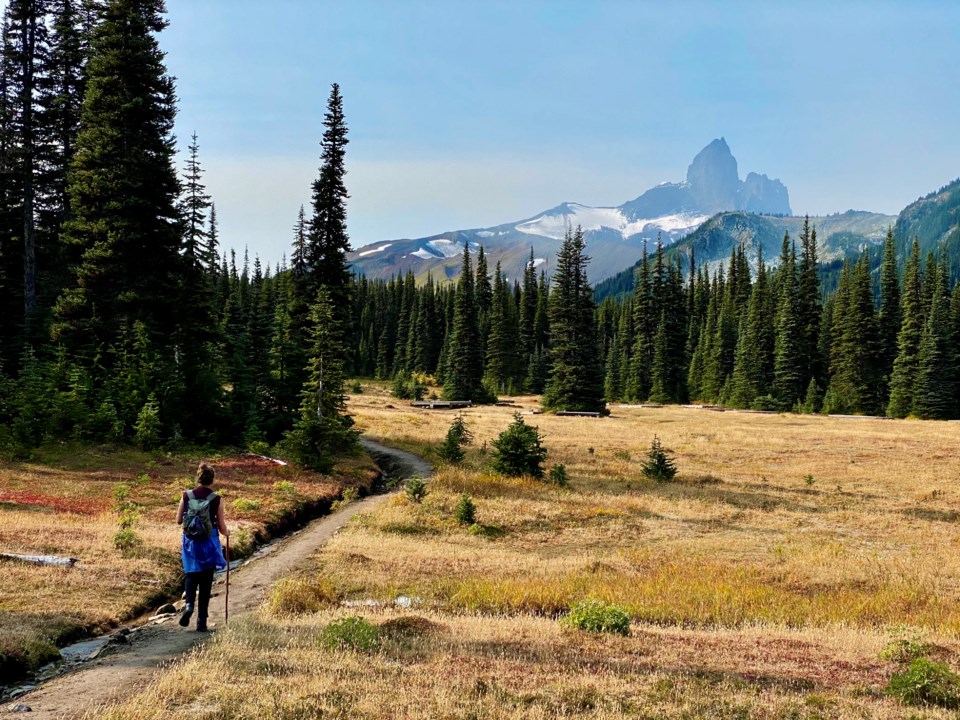What is wilderness?
I remember the thought pinballing through my head as I rafted a 100-kilometre stretch of the Wapiti River from remote northeastern British Columbia into even remoter northwestern Alberta. Other than our launch point, there’d been zero sign of humanity. Only what seemed original forest and a wild, at times unnavigable watercourse, from which we gratefully fished grayling and bull trout.
The wilderness of deep time was also represented in this unexplored reach, where 95-million-year-old dinosaur footprints as long as my arm graced sandstone shelves lining the riverbank, and the beasts’ fossilized bones eroded regularly from higher strata to cascade down to river level. And yet, despite the distinctly removed feel, I knew that unseen, just above the canyon walls, spread the Peace District’s true leitmotif—myriad oil, gas and coal leases amidst a sea of forestry clear-cuts. The trip had joined other assignments around that time that also left me contemplating the true nature of wilderness.
The summer before, the notion had plagued me while descending the northern Yukon’s Snake River, a 300-kilometre watercourse widely considered to be pristine—no roads, no residents, no development. By the standards of those who purported to want to protect this chunk of the larger embattled Peel watershed—be they First Nations, governments, NGOs or individuals (industry doesn’t deserve inclusion here because even if they said they did, they didn’t)—this was considered wilderness personified. But was it? At the time, everyone from canoe and hunting outfitters to mining and oil interests seemed to think they could have a piece of this untrammeled area without altering its fundamental nature. “Wilderness,” something that should intuitively lack ownership, suddenly had plenty of stakeholders.
Having grown up canoeing Ontario’s Algonquin Provincial Park, a wilderness to me at the time but, in hindsight, ersatz reclamation at best, I circle back to this thought a lot. Especially in Whistler while I’m picking up garbage strewn along watercourses or doggy-bagging someone’s shit-stained toilet paper in a grove of old-growth. It’s a paradox; I’m cleaning this stuff up because I desperately want something to be wilderness that part of me already believes isn’t.
Ultimately, the definition I’d mulled on those river trips was always a matter of degree: not this, but that; some, but not all; us but not them. As many variants as special interests concerned with it. The problem was that each of these constructs was ours—relative and contextual. Perhaps real wilderness simply defined itself by functionality: the natural intertwining of landforms and waterways; the presence of endemic, co-evolved plant and animal life; intact ecosystems operating the way they have since they arose.
There’s room for humanity in this conceptualization, if we remain a part and not apart, which may demarcate the difference between colonists’ “over there” concept of wilderness and the participatory wilderness of First Nations. Years ago, I asked Guujaaw, a renowned artist and then president of the Haida Council, about the relationship between the cultural depth of his people and the biological depth of Haida Gwaii. “Our rich culture reflects the richness of both land and marine wildernesses,” he’d replied.
It’s hard to argue that a sustainable existence which doesn’t destroy ecosystems can preserve something akin to wilderness, but I’d heard other, more facile ideas while investigating the widespread counterintuitive belief in monsters like Lake Okanagan’s celebrated Ogopogo. “Humans love mystery and discovery,” mused someone whose parents claimed to have seen the creature. “Life would be horrifically dull if we knew everything there was to know. We want to believe there are things out there that can’t be explained.”
Indeed, our need to embrace the unexplained is inherent in the fabric of self-consciousness it co-evolved with. Is this where wilderness lies? Nature would, in fact, lose much of an identity rooted in wonder if it were fully circumscribed—and so would we. Consider the famous Sasquatch aficionado who, despite spending enormous amounts of time, money and energy searching for the mythical creature, in a moment of startling candour admitted to an interviewer: “It would actually be a shame if we found one. Without Bigfoot out there, there’s no such thing as wilderness left.”
Which begs the interesting question of which is worse for humanity—the failure of investigation, or the failure of imagination?
In the end we’re back to the beginning: is wilderness no human footprint or very little? Does long human use and transient habitation qualify or disqualify? Without consensus, do we simply look to nature for answers about how and what to preserve? Or do we require a new definition in this age of reclamation, where an historically (and currently) logged territory like Algonquin represents the largest preserved “wilderness” in Ontario. And what of piecemeal protection, such as allowing a land-scarring mine that may benefit society—but only as long as the resource or changing economics of demand last—when we know that true wilderness, the type the Earth doesn’t make anymore, offers the wealth of connection in perpetuity?
Without intention, I’ve confronted this conundrum my whole life, from nature-addled kid through professional work as a biologist, teacher, traveller and writer. And yet, despite all my cognitive churning, and the many contributions of others, still the question lingers: What is wilderness?
Maybe it’s just something we have to keep asking, before the answer is “nothing.”
Leslie Anthony is a Whistler-based author, editor, biologist and bon vivant who has never met a mountain he didn’t like.




